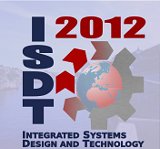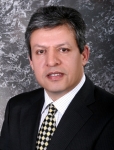Keynotes
- Moe Khaleel (Pacific Northwest National
Laboratory):
Recent Development in High Temperature Fuel Cell
System
About the speaker: Dr. Khaleel is the Director of the
Computational Sciences and Mathematics Division with
capabilities in high performance computing, computational
physical and biological sciences, scientific computing
environments, informatics analytics, applied mathematics,
and statistical and quantitative Sciences. Dr. Khaleel is
an international leader in multiphysics and multiscale
modeling of solid oxide fuel cells and lightweight
materials. Dr. Khaleel's national coordinator for the
modeling and simulation of solid oxide fuels for the
Department of Energy Solid Energy Conversion Alliance
(SECA). Dr. Khaleel published over 100 referred journal
article and has received the award for Excellence in
Technology Transfer of superplastic forming of aluminum to
General Motor Company, Federal Laboratory Consortium for
Technology Transfer, May 10, 2000; the ASME International,
McGrattan Literature Award for authoring the outstanding
paper in the Journal of Pressure Vessel Technology in 1998
“Effects of Flaw Sizing on Reliability of Piping;” Battelle
Memorial Institute Technical Network Leader of the Year
(2001); Suksdorf Fellowship at Washington State University
(WSU), 1990-1992.
- Saeid Nahavandi (Deakin University):
Knowledge management in product design and process control
through simulation modelling and analysis
Abstract: Knowledge often gets lost if it is not captured
in a timely manner and managed adequately and appropriately
in many industries. This talk will focus on embedding
knowledge in processes and products through the use of
simulation based optimization to streamline production
systems while improving product quality. New tools and
techniques developed to achieve an integrated rapid
modelling of product and processes will be examined.
Industry based case studies will be used to demonstrate the
mechanism of knowledge capture on a series of processes and
products. State of the art simulation tools are used to
show how product design and process simulation can be
integrated to increase the system profitably while
improving the product quality.
About the speaker: Saeid Nahavandi is Alfred Deakin
Professor in the School of Engineering and IT, Deakin
University, Australia. Saeid is a graduate of Durham
University in the UK. He is a Fellow member of IET, IEAust
and senior member of IEEE. Professor Nahavandi has
published over 270 refereed papers and been awarded 13
competitive Australian Research Council (ARC) grants in the
past five years. He received the Research collaboration /
initiatives award from Japan (2000) and Prince &
Princess of Wales Science Award in 1994. He won the title
of Young Engineer of the Year Award in 1996 and holds one
patent. In 2002 Professor Nahavandi served as a consultant
to Jet Propulsion Lab (NASA) during his visit to JPL Labs.
In 2006 he received the title of Alfred Deakin Professor,
the highest honour at Deakin University for his
contribution to fundamental research. Professor Nahavandi
is the founder and the leader for the Intelligent Systems
Research Lab. with 51 full time researchers at Deakin
University. He actively contributes and leads four major
research projects in three Cooperative Research Centres
with over 50 major international companies as partners. In
modelling and simulation of complex systems he received
awards from several organisations to focus on simulation
based optimization manufacturing processes, of airport
operations and logistics and distributions. He has carried
out industry based research with major international
companies such as Ford, Nissan, General Motors, Bocsh,
FUTURiS, FESTO, Omron just to name a few. Professor
Nahavandi was the designer of the control / electronics and
drive system for the World’s first largest (6x8 meters)
3-dimensional Intelligent Interactive Surface which
appeared at the Hanover CIBIT International Electronics
Trade Show in Germany and at the IMTS in Chicago (2006).
For his expertise and contribution in modelling, robotics
and counter terrorism he was selected by the Australian
Army / DSTO to deliver a Haptically Operated
Counterexplosive mobile Platform in 2006. He also holds a
research project with the Joint Strike Force (F-35)
developing haptics and Augmented Reality. Professor
Nahavandi has been the chairman of six International
conferences and the General Chair for World Manufacturing
Congress series and the International Congress on
Autonomous Intelligent Systems. He also holds the position
of Editor for the International Journal Intelligent
Automation and Soft Computing (South Pacific region),
International Journal of Computational Intelligence and
Associate Editor - IEEE Systems Journal.
- Arno Evers (Arno A. Evers FAIR-PR):
Nano Technologies: The needed accelerator for Hydrogen and
Fuel Cells
About the speaker: Arno A. Evers FAIR-PR is the founder of
the Group Exhibit Hydrogen + Fuel Cells at the annual
HANNOVER FAIR since 1995. In 2006, Arno Evers sold his
unique fair concept to Deutsche Messe AG. His former
employee, Tobias Renz founded his own company Tobias Renz
FAIR-PR; he and his team will now be operating the Group
Exhibit Hydrogen + Fuel Cells, as of the HANNOVER FAIR
2007. While he began his career in oil exploration in the
Persian/Arabian Gulf, his main background lies in the
European aircraft industry. For 23 years he led the PR
department of the German Messerschmitt- Boelkow-Blohm GmbH
(MBB) Company and was specifically engaged in implementing
the European Airbus aircraft into the worldwide market from
1969 and onwards. In the beginning of the 1990's, Arno
Evers founded his own company with the target to make new
technologies understandable for the public, media and
politicians at international trade fairs such as the
world's biggest computer fair CeBIT and others. He is now
engaged worldwide at H2/FC conferences and other events in
informing audiences about the possibilities to attend the
Group Exhibit Hydrogen + Fuel Cells at the annual HANNOVER
FAIR. Here he invites potential and existing exhibitors and
trade show visitors to attend.
- Bernd Emonts (Research Centre Jülich):
Fuel Cells – Status and Development Demands of a Future
Energy Conversion Technology
About the speaker: Dr.-Ing. Bernd Emonts, age group 1957,
studied mechanical engineering at the University of Aachen.
After completing his doctoral thesis in the year 1988, he
took on scientific functions in the field of “Catalytic
Comustion” at the Research Centre Jülich (Institute for
Energy Process Engineering). In 1996 Dr.-Ing. Emonts took
on responsibility as Project manager for the field of
“Low-temperature Fuel Cells”. In 1999 he became Head of the
Department “Plant and Systems Technology” and in 2001
Project manager “Low-Temperature Fuel Cells” at the
Institute of Energy Research. Since 2005 Dr.- Ing. Emonts
is Deputy Head of the Institute of Energy Research – Fuel
Cells (IEF-3).
- Robert L. Snyder (Georgia Institute of
Technology):
The Microstructure of Ceramic Nanostructures
Astract: The many developments in nanotechnology in recent
years have opened the door to a great number of nano-scale
applications. The very high surface free energy of these
materials offers unique properties as well as unique
challenges. The sensing properties of nano-materials are
markedly influenced by their microstructure, as
nano-materials with different microstructure will
consequently exhibit different physical properties. In this
talk I will start with a fundamental examination of the
structure of nano-materials and the various tools we have
for elucidating this structure. The disordered shell around
a periodic Bragg type core structure presents the biggest
challenge to our understanding and ability to model
properties. Next we need to examine the impact of
nanostructure on microstructure and again the tools we have
to determine these effects. The microstructure of materials
is given by fundamental features, such as: (i) the
crystallite size, (ii) size distribution, (iii) the defect
structure/distribution, (iv) texture, etc. The two
principal tools for describing the microstructure of
nano-particles are electron and X-ray probes. The shadow
images of the TEM give information about overall structure
while electron diffraction provides information about the
primary nanostructure in a very small region. X-ray
diffraction provides complimentary information about the
defect structure by showing the average coherence length as
a function of direction. This talk will review of the
applications of X-ray diffraction methods to determining
the microstructure features of nano-materials and a
recently developed X-ray diffraction method for
characterization of single nano-objects.
About the speaker: Robert L. Snyder is Professor and Chair
of the School of Materials and Engineering at The Georgia
Institute of Technology. He is the author of two textbooks,
has edited nine technical books and has contributed
chapters to nine books and encyclopedias. He holds eight
patents and has published over 280 papers on materials and
materials characterization which have been cited by other
authors more than 2000 times. He has presented over 1,000
talks around the world with over thirty plenary and keynote
lectures. He is a Fellow of the American Society of Metals,
The American Ceramic Society and Distinguished Fellow of
The International Centre for Diffraction Data. He is a
Principal Editor for the Journal Materials Research and the
Journal of the American Ceramic Society. He serves on the
organizing committees of a number of international
conferences and chairs the annual Denver X-ray Conference.
He has been named the American Ceramic Society Outstanding
Educator and has received the State University of New York
Chancellor’s Award for Excellence in Teaching, the 2002 TMS
Award for Materials Leadership and the 2004 Hanawalt Award
for X-ray analysis and the 2008 TMS Educator Award.
- Lutz-Eike Elend (AUDI AG):
Key technologies and materials for future automotive
applications
About the speaker: Dr.-Ing. Lutz-Eike Elend, age group
1971, studied mechanical engineering in the field of
production technology and production engineering at the
University of Hanover. After completing his doctoral thesis
at the institute of metal forming and metal forming
machines in the year 2001, he took on executive functions
as program manager and key account manager in the
automotive field of the Alcan Aluminium Valais SA in
Sierre/Switzerland. In 2004 Dr.-Ing. Lutz-Eike Elend joined
the Audi AG, where he took on responsibility for the field
of light construction technology for the Audi Space Frame
principle. Since May 2007 he is head of light construction
technology and process development in the “Aluminium- and
Leichtbauzentrum” of Audi AG in Neckarsulm, Germany.
- Bernhard Sepeur-Zeitz (Volkswagen AG):
Nanotechnology in Automotive Engineering




